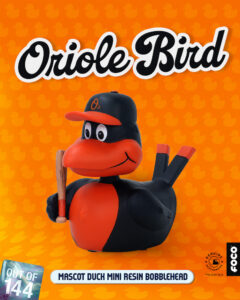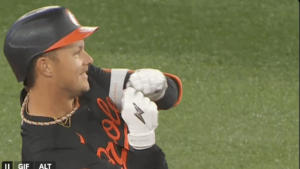If you’re a sabermetrics veteran, one who regularly tosses around fancy stats without effort, this isn’t the post for you. Click on back and go about your day perusing FanGraphs or Camden Depot or whatever it is you brainiacs do while trying to distill baseball for the rest of us (thanks for it all, by the way). This post is for SABR N000Bs. If you’re just dipping your foot in the SABR waters, I’m here to be a comforting hand to hold as we wade in together.
Listen, I love baseball card stats – tell me a hitter’s batting average, home runs, RBI, and stolen bases. Give me a pitcher’s ERA. Regale me with fielding percentage and number of errors. I’m not here to poo-poo any of those things, but what I’ve learned to do over the past several years is to open up my mind to other tools that very smart people have created and are now using to evaluate baseball players. While I resisted for years, once I overcame that resistance, a whole new world opened up. Things like FIP (Fielding Independent Pitching), O-Swing% (the percentage of times a batter swings at pitches outside of the strike zone), UZR (ultimate zone rating, a defensive metric, which SABR folks will even tell you they’re still working to refine) and more have only increased my enjoyment of our national pastime.
I’m not here to tell you that those old baseball card stats are wrong or that you should ignore them, by the way. Perhaps new tools aren’t your thing. Maybe you’re Harold Reynolds. Whatever. I’m just relaying my own experience, and saying that if you’re open minded to the fancy stats, I’ll be happy to count you as a peer as we all learn about this stuff together.
Perhaps this will be a one-off type of post. Maybe it will turn into a series of SABR lessons for dummies. I’m not really sure yet. Whether this ends up as a weekly seminar or just a unique lesson, welcome to class. Let’s try to get a little smarter today.
First Topic: wOBA
This is one that seems to come up more and more these days. wOBA, pronounced whoa-ba. Or, if you prefer the Natty Boh cap method:
 + buh
+ buh
wOBA stands for Weighted On Base Average.
The first thing we need to do is to admit to ourselves and those nerds snickering at us from outside the window that yes, we’re late to the party on this. The better part of a decade late. Noted. That’s bad and we should feel bad, we get it. Now, let’s move on.
For the sake of completeness, we’re going to take a look at the formula for wOBA, but I beg you to not stare directly at it for too long:
/knocks on the desk
I see that I’ve lost some of you. At least two folks snuck out the back door there, while a good half of our attendees fell asleep in their seats. Understandable. However, for those of you still with me, we’re going to press on, and I promise that things will get much more interesting from here on out.
Now, you might be saying “why do I need another tool to tell me how good a hitter is? We have OPS for that, and that’s all the damn fancy stats I need!” To that I reply that yes, I said this same thing for a long time.
Until very recently, I heard “wOBA,” and thought to myself “whoa, buuuuuut what about about his OPS+?”
OPS is fine. OPS+ has long been a favorite of mine, due to its simplicity of interpretation. OPS+ is listed on every player’s Baseball Reference page, right up there next to all the usual baseball card stats. 100 is the average for all players, so if a player has an OPS+ of 120, he was 20% better than average for that year. If he was at 90, he was 10% worse than average.
Easy, peezy.
However, OPS, and by extension, OPS+, both share some limitations that make them less useful than wOBA. Namely, that they are just adding up two stats that really aren’t meant to be just summed up. The OPS siblings ignore that the difference between getting on base and not getting on base is greater than the difference between smacking extra base hits and recording a single or a walk.
So, the SABR guys started looking for something better, and what Tom Tango came up with was wOBA. Tango also gave us the aforementioned FIP. Just like he did with FIP, scaling it to match ERA numbers, Tango scaled wOBA to look like OBP. So, if you’re already good at recognizing a solid OBP, congrats, you’re ahead of the game, as you can now also recognize a solid wOBA at a glance.
Let’s take a look at the wOBA leaders on the 2015 Orioles as an example (min PA 100):
And, the AL leaders (min PA 300):
So, pretty much the players who come to mind when you think of the best hitters in the American League, right? Makes sense.
So, what are some other things to know about wOBA? Well, as runs in baseball have been going down, so has the league average wOBA, as you can see in this FanGraphs….graph.
It bottomed out in 2014 at .310 before rebounding a bit, to .313 in 2015. FanGraphs has a list of the league averages and the resulting coefficients for the wOBA formula here. But again, only the masochists among us will worry about calculating wOBA on their own. For everyone else, just look it up and trust what the interwebs tells you.
Since wOBA is weighted to league run environment for that season, you can’t really compare players’ numbers from different years as apples-to-apples. For example, in 2009 Joe Mauer led the AL with a .438 wOBA. However, he wasn’t really 23 points better in wOBA than Mike Trout was last year. Mauer was .109 over the league average, while Trout bested it by .102. So Mauer was about nine points better in wOBA than Trout. I say about because other factors come into play, like standard deviation to the league average and other things that statisticians consider. To get a truly accurate comparison, you’d have to divide and use percentages, etc. and it becomes a whole thing. (h/t to Patrick Doughterty and Matt Perez for steering me on this one).
But let’s not get too wrapped up in that sort of thing, as I know it produces some eye-glazing from many, and that’s what can scare many folks away from using advanced stats like this. Baseball fans like their round numbers, and their historic records that can be compared between eras. Don’t think of wOBA in that way – or if you do, just realize that you’re not getting a complete picture, and you’ll be fine.
To wrap up, let’s review – wOBA takes into account a player’s unintentional walks, hit-by-pitches, singles, doubles, triples, and home runs. It multiplies each by a specific value that we don’t really need to worry about because we’re not calculating this ourselves, and spits out a number that looks like an OBP, that’s already been weighted to the average OBP of all players that season. Ta da!
If a player has a wOBA of .315 or so, he’s probably pretty average. .350, we’re talking All-Stars, .370 or higher, franchise players who can carry a team (20 players in MLB had a wOBA of .370 or higher in 2015).
So there you have it. wOBA. The next time you’re listening to Bird’s Eye View, and Scott is on the mic, you’ll have some idea of what the heck he’s talking about.
Let me know if you guys enjoyed this little lesson, and if so, we’ll do some more SABR for Dummies seminars in the future.
Further Reading















